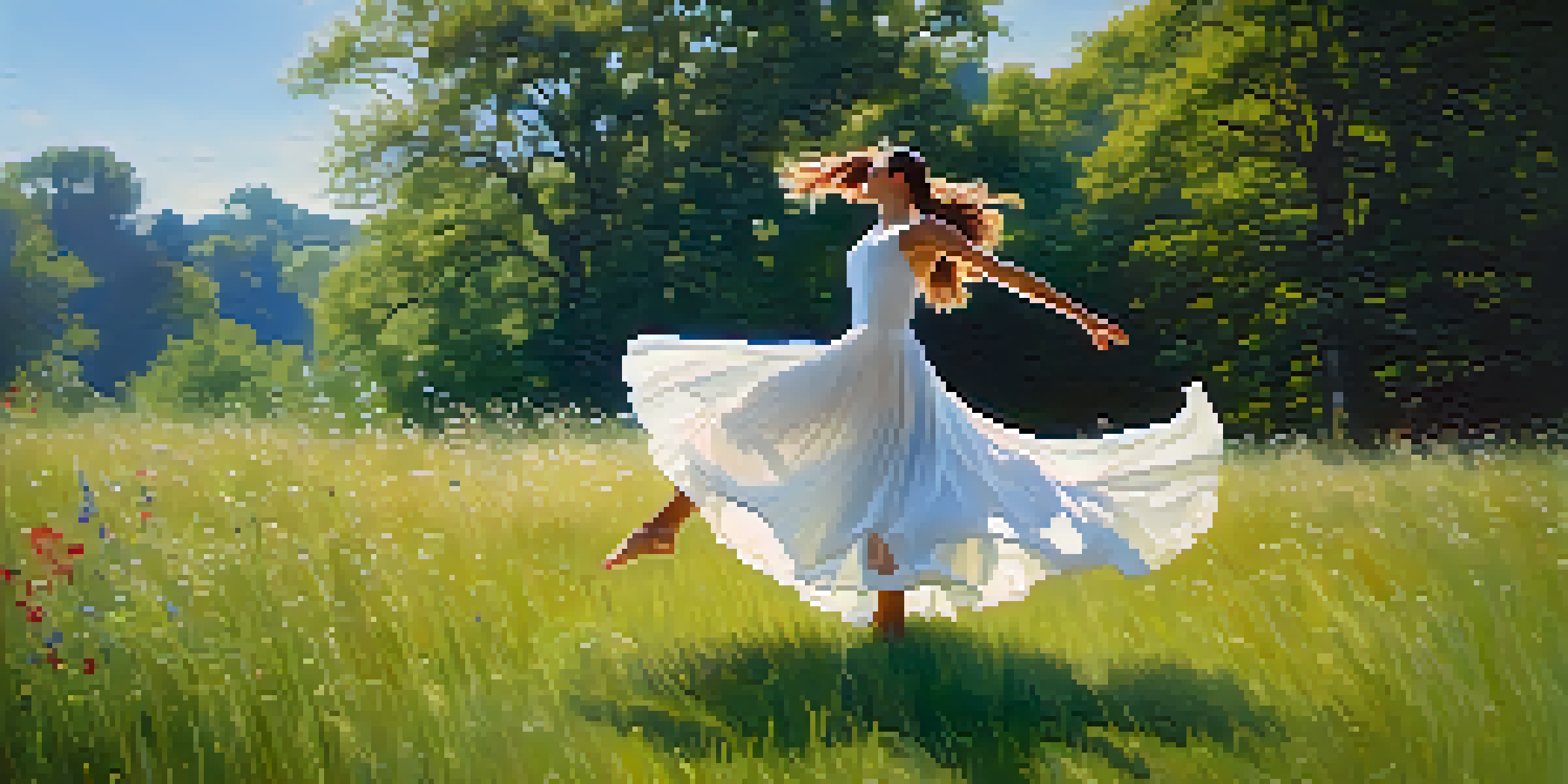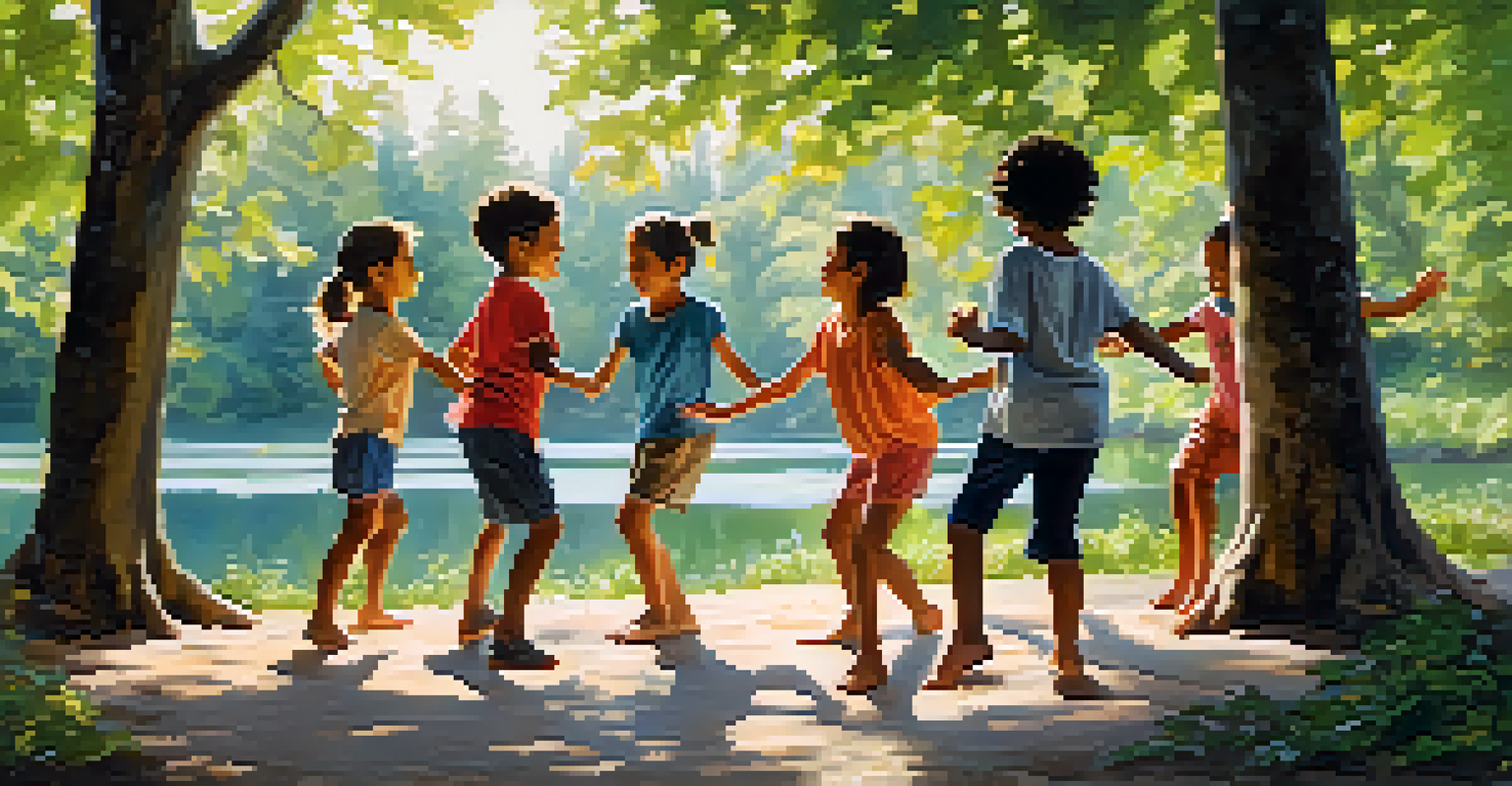Choreography Inspired by Nature: Dance for the Environment

The Connection Between Dance and Nature
Dance has always been a powerful form of expression, and when influenced by nature, it takes on an even deeper significance. Movements can mimic the flow of rivers, the rustle of leaves, or the dance of animals, creating a visceral connection to the environment. This relationship serves not only as an artistic exploration but also as a reminder of our bond with the natural world.
Dance is the hidden language of the soul.
By drawing inspiration from natural elements, choreographers can create works that resonate with audiences. For example, a dancer's fluid movements could echo the gentle sway of grass in the wind, reminding us of the beauty surrounding us. These connections foster a sense of appreciation for our planet and can motivate viewers to consider their role in preserving it.
Moreover, nature-inspired choreography often evokes emotional responses that words alone cannot convey. Just as a sunset can leave us in awe, the beauty of movement inspired by the environment can inspire change. When we see dance as a reflection of nature, we are reminded of the importance of protecting it.
Choreography as a Tool for Environmental Advocacy
Choreographers are increasingly using their art to advocate for environmental issues. Through powerful performances, they can highlight pressing concerns such as climate change, deforestation, and pollution. This approach not only educates audiences but also inspires them to take action in their own lives, creating a ripple effect of awareness.

For instance, a dance piece centered around the plight of endangered species can evoke empathy and encourage conservation efforts. By showcasing the grace and beauty of these animals through movement, dancers can create a poignant narrative that resonates deeply with viewers. This emotional connection can be a catalyst for change, prompting individuals to engage more actively in environmental protection.
Dance Reflects Nature's Beauty
Choreographers draw inspiration from nature, creating dance movements that evoke the beauty and complexity of the natural world.
Furthermore, collaborative projects between dancers and environmental organizations can amplify their message. By partnering with scientists, activists, and conservationists, choreographers can create multi-disciplinary performances that inform and inspire. This fusion of art and advocacy can reach diverse audiences and foster a broader conversation about the importance of safeguarding our planet.
Nature's Influence on Movement Styles
Different styles of dance can be influenced by various aspects of nature, leading to unique expressions of movement. For example, ballet's graceful lines can reflect the elegance of a swan gliding across a lake, while contemporary dance might capture the raw power of a storm. Each dance style offers a different lens through which to explore our connection with the environment.
The earth has music for those who listen.
Additionally, traditional dances from various cultures often celebrate the natural world. Indigenous dances, for instance, may reflect seasonal changes or honor specific elements like water and earth. By incorporating these movements into contemporary choreography, dancers can preserve cultural narratives while also promoting environmental awareness.
Ultimately, the influence of nature on dance styles enriches the art form and deepens the connection between performer and environment. As audiences witness these interpretations, they may find themselves more attuned to the natural world and its rhythms, inspiring them to protect it.
The Role of Music in Nature-Inspired Dance
Music plays a crucial role in enhancing the emotional impact of nature-inspired dance. The sounds of nature—like birdsong, rustling leaves, or flowing water—can be woven into the soundtrack, creating an immersive experience for audiences. This connection between sound and movement deepens the narrative, making the performance even more poignant.
Moreover, composers often draw inspiration from nature when creating music for dance. Genres that incorporate natural sounds or themes can evoke specific feelings that align with the choreography. For example, a piece inspired by a thunderstorm might feature dramatic crescendos, mirroring the intensity of the dance movements.
Art as Environmental Advocacy
Dance serves as a powerful tool for raising awareness about environmental issues, encouraging audiences to take action.
By marrying music with choreography, dancers can transport audiences to different environments, allowing them to experience the beauty and urgency of nature. This synergy not only elevates the performance but also reinforces the message of environmental stewardship.
The Impact of Dance on Audience Awareness
When audiences witness dance inspired by nature, they often leave with a heightened sense of awareness about environmental issues. The visceral experience of seeing movement that embodies the elements can stir feelings of responsibility and connection. This emotional engagement is crucial in motivating individuals to reflect on their own impact on the planet.
For example, a performance that powerfully illustrates the effects of climate change can leave a lasting impression. As viewers absorb the narrative through dance, they may begin to consider their role in combating these challenges. The combination of art and advocacy creates a unique platform for raising awareness that traditional methods may not achieve.
Ultimately, the impact of dance extends beyond the stage, igniting conversations about conservation and sustainability. This ripple effect can lead to community action, encouraging individuals to participate in local environmental initiatives, thereby amplifying the message of the performance.
Educational Programs Merging Dance and Nature
Educational programs that merge dance with environmental education are becoming increasingly popular. These initiatives allow students to explore nature through movement, fostering a deeper appreciation for the environment. By engaging with the natural world in a creative way, participants can develop a sense of stewardship that lasts a lifetime.
For instance, workshops that focus on creating dance pieces inspired by local ecosystems can promote both artistic expression and environmental awareness. Students learn to observe their surroundings closely, translating their observations into movement. This hands-on approach emphasizes the importance of nature while nurturing creativity.
Education Merges Dance and Nature
Educational programs that combine dance with environmental education foster appreciation for nature and cultivate future advocates.
Such programs also encourage collaboration across disciplines, bringing together educators, dancers, and environmentalists. This multi-faceted approach can lead to innovative projects that educate and inspire communities. By investing in these educational opportunities, we can cultivate a new generation of artists who are passionate about both dance and environmental advocacy.
Future Directions for Dance and Environmental Advocacy
As the world faces increasing environmental challenges, the role of dance in advocacy is likely to grow. More choreographers are recognizing the potential of their art to inspire change and are seeking innovative ways to incorporate environmental themes into their work. This shift not only enriches the art form but also contributes to the broader movement for sustainability.
Future performances may leverage technology, using digital media to complement live dance and enhance storytelling. This could include projections of natural landscapes or even real-time data visualizations of environmental changes. By embracing these tools, dancers can reach wider audiences and create a more immersive experience.

Ultimately, the future of choreography inspired by nature holds great promise. As artists continue to explore their connection to the environment, they will undoubtedly find new ways to engage and inspire audiences, fostering a collective commitment to protecting our planet.